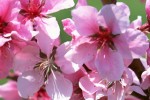
A native of China, the peach is a small deciduous short lived tree in the rose family, Rosaceae, and in the same genus as plums, cherries, almonds, and apricots. Nectarines are the same genus and species but a different variety. The trees grow up to 25′ tall and have upward reaching branches that form an open rounded crown. New growth is red and green turning gray-brown with maturity. The shiny dark green leaves are lanceolate, pinnately veined, and three to six inches long. The flowers appear singly before the leaves in spring and may be single, semi-double, or double. They are one inch across, have five petals, and are white to red. The fleshy edible fruits ripen in mid-summer, are three inches across, and have a single brown seed with a woody husk. The flesh of the peach can be white or yellow and the seed may stick to the stone (clingstone) or be free from it (freestone). Peach trees are grown for both the beauty of their bloom in spring and for the fruit they produce but they are difficult to grow well. They need hot summers and cold winters and suffer damage from many pests and diseases. Many varieties are available and care should be taken to select the ones that are known to do well in a specific area. Most varieties are self-pollination. The genus name, Prunus, comes from the Greek word προύνη meaning plum, a prominent member of this genus. The specific epithet, persica, is the Latinized name for Persia, the believed place of origin of the peach.

Type: Deciduous flowering fruit-bearing tree
Outstanding Features: Flowers, fruits
Form: Loose rounded canopy
Growth Rate: Moderate
Bloom: Five-petaled , 1 inch wide, white to red flowers appear singly before the leaves in spring and may be single, semidouble or double.
Size: 15-25’ H x 15-25’ W
Light: Full sun
Soil: Average, deep, moderately moist, well-drained; does not tolerate alkali, salt, or boggy soils.
Hardiness: Zones 5-9
Care: Head young trees to 24” from the ground and allow three main branches evenly spaced around the trunk at the top to establish a framework. Annual pruning to encourage twig production and maintain openness is needed.
Pests and Diseases: Borers, aphids, spider mites, scale, peach leaf curl, mildew, brown rot, blight, rust, mosaic, stony pit, peach scab, bacterial canker, and leaf spots, are some of the diseases that plague peaches.
Propagation: Semi-hardwood cuttings